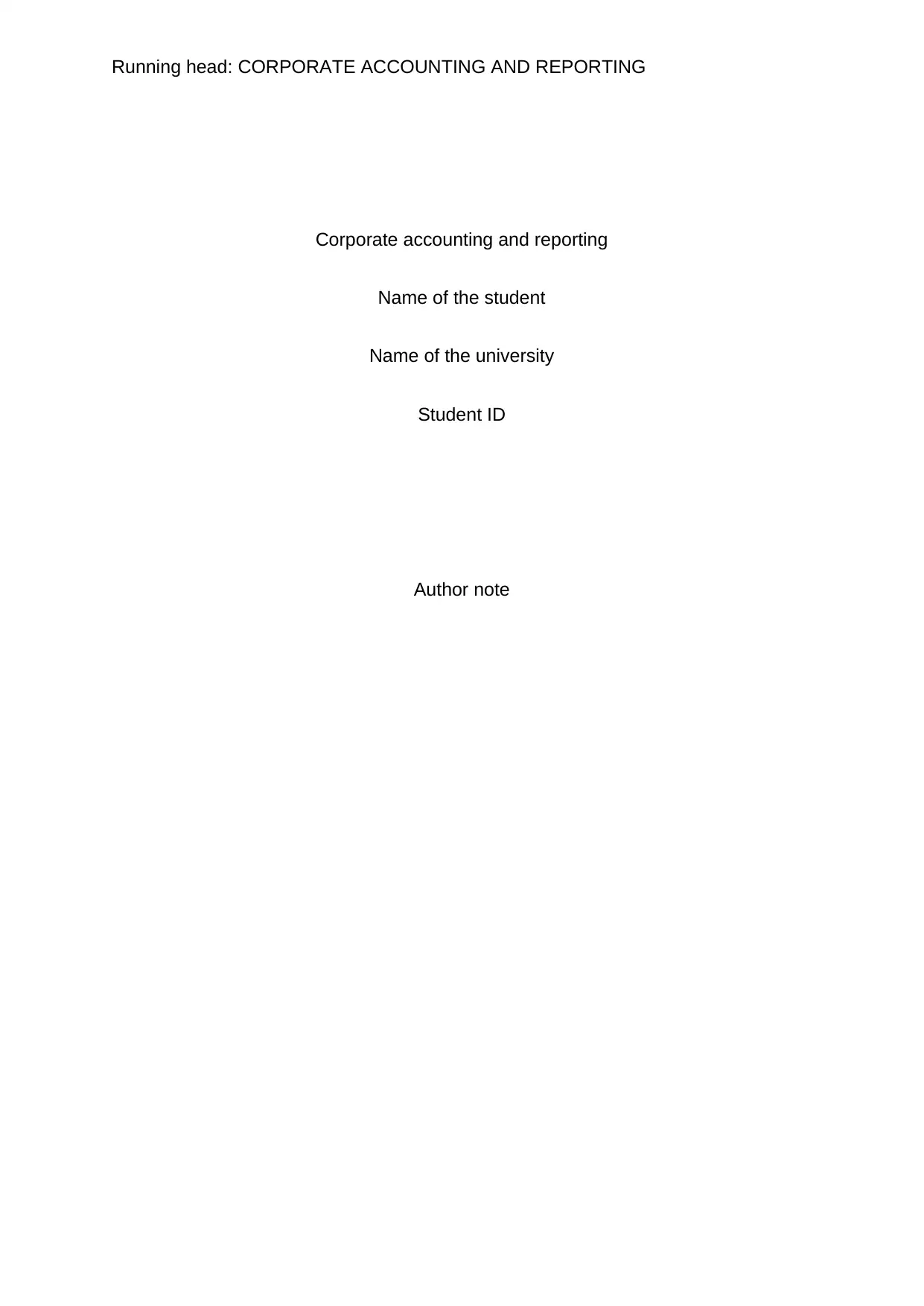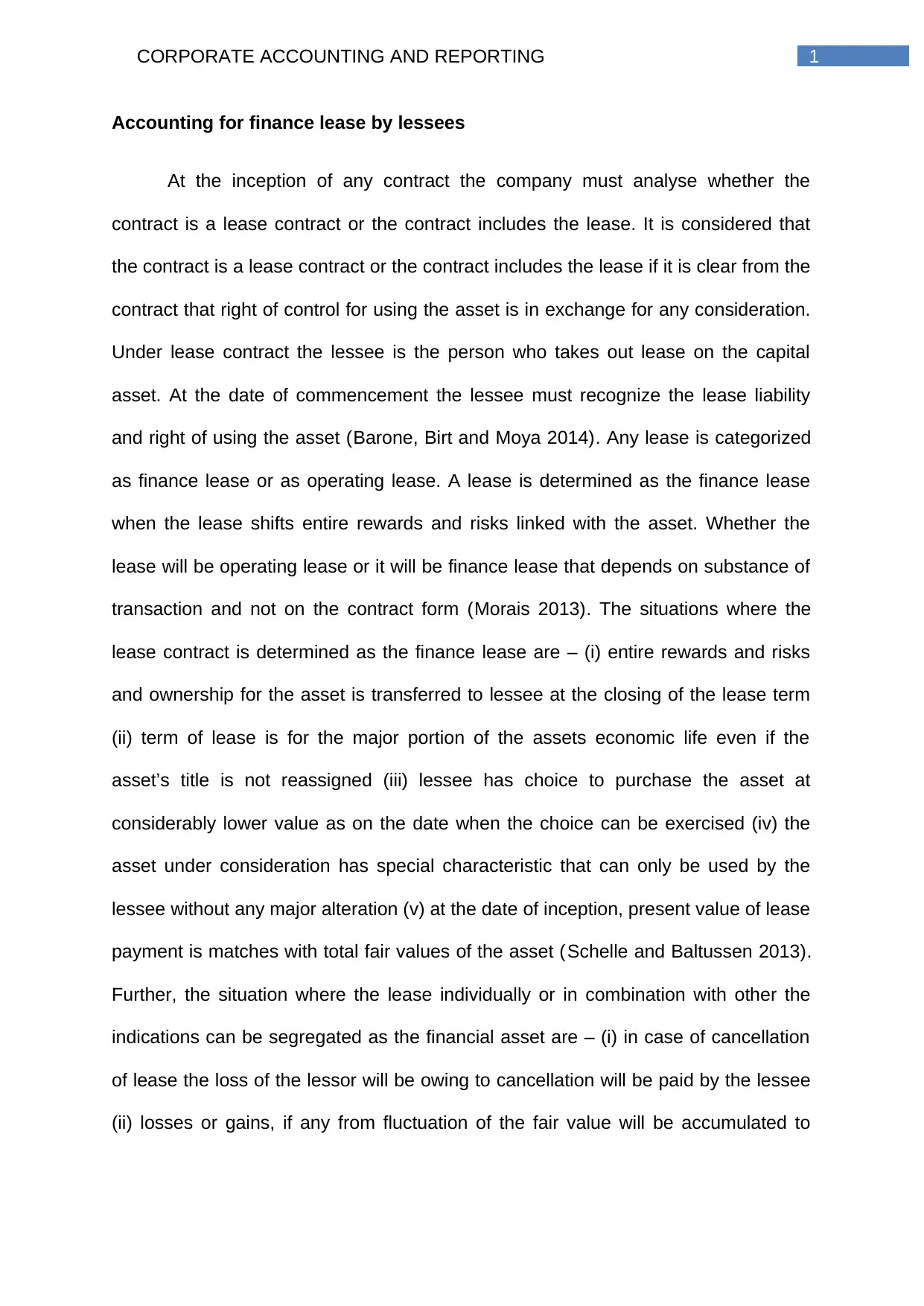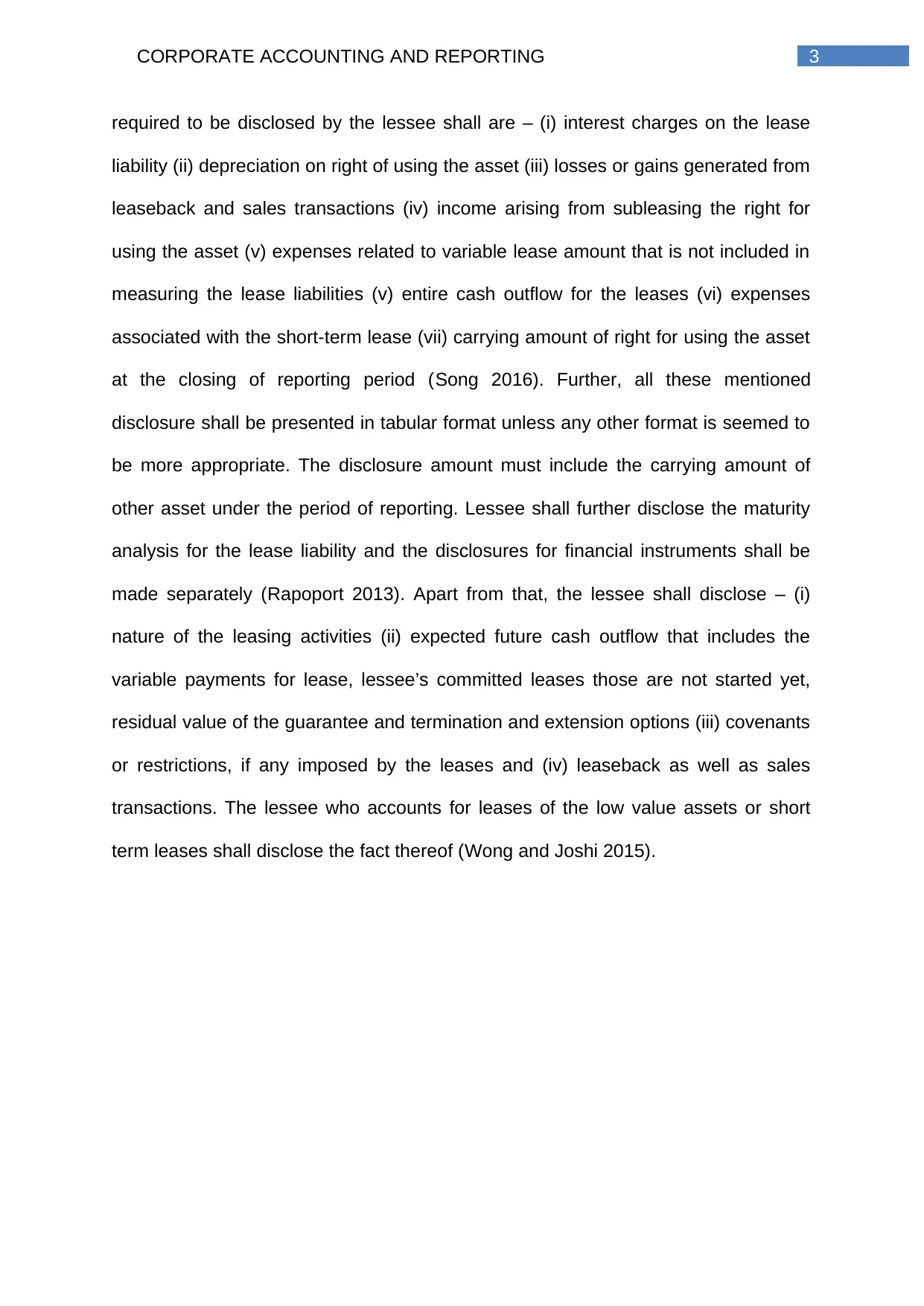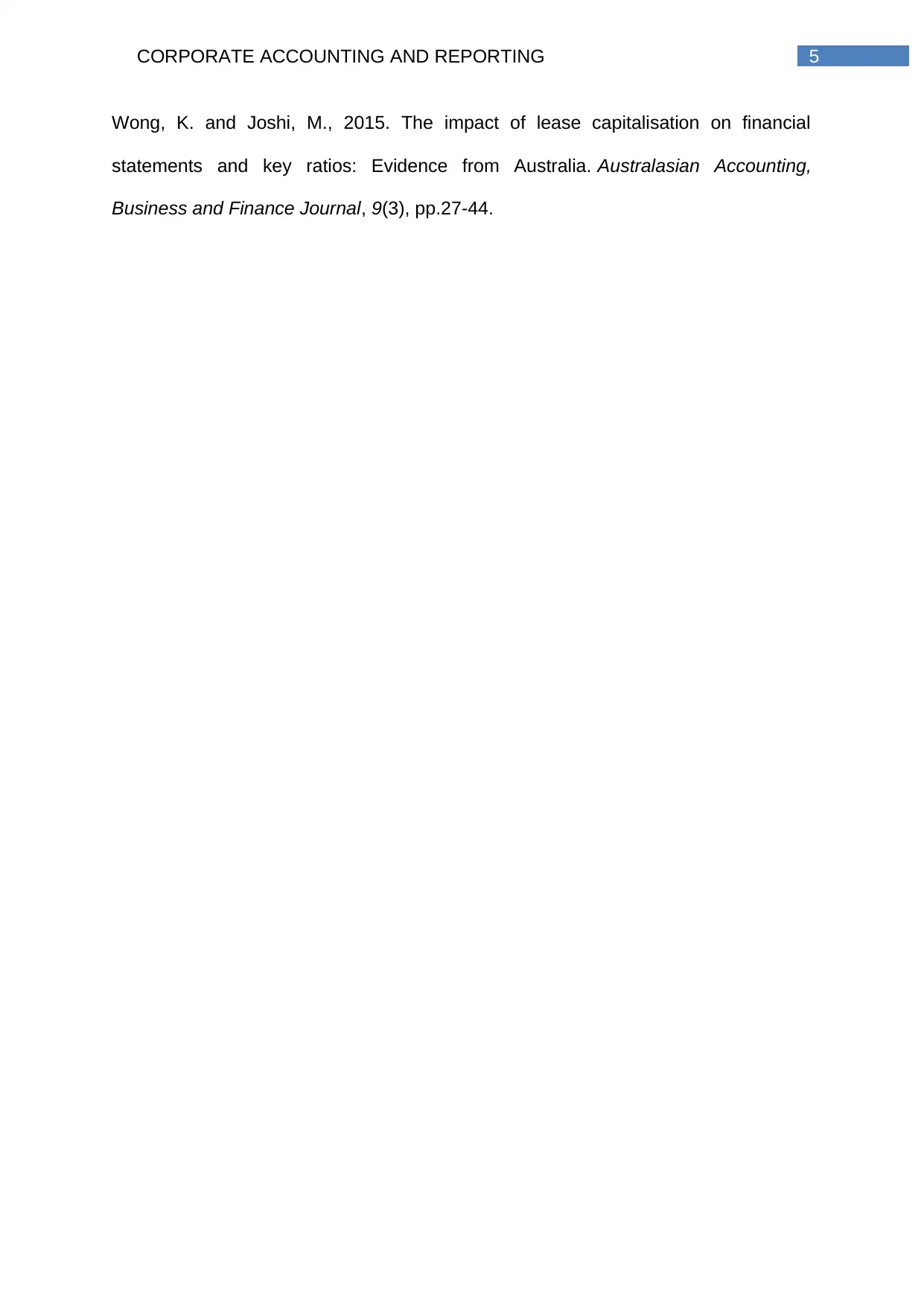Accounting for Finance Lease by Lessees
VerifiedAdded on 2023/06/08
|6
|1377
|322
AI Summary
This article explains the accounting treatment for finance lease by lessees, including the recognition of lease liability and right of using the asset, categorization of lease as finance or operating lease, reporting of finance lease in financial statements, and disclosure requirements for lessees.
Contribute Materials
Your contribution can guide someone’s learning journey. Share your
documents today.

Running head: CORPORATE ACCOUNTING AND REPORTING
Corporate accounting and reporting
Name of the student
Name of the university
Student ID
Author note
Corporate accounting and reporting
Name of the student
Name of the university
Student ID
Author note
Secure Best Marks with AI Grader
Need help grading? Try our AI Grader for instant feedback on your assignments.

1CORPORATE ACCOUNTING AND REPORTING
Accounting for finance lease by lessees
At the inception of any contract the company must analyse whether the
contract is a lease contract or the contract includes the lease. It is considered that
the contract is a lease contract or the contract includes the lease if it is clear from the
contract that right of control for using the asset is in exchange for any consideration.
Under lease contract the lessee is the person who takes out lease on the capital
asset. At the date of commencement the lessee must recognize the lease liability
and right of using the asset (Barone, Birt and Moya 2014). Any lease is categorized
as finance lease or as operating lease. A lease is determined as the finance lease
when the lease shifts entire rewards and risks linked with the asset. Whether the
lease will be operating lease or it will be finance lease that depends on substance of
transaction and not on the contract form (Morais 2013). The situations where the
lease contract is determined as the finance lease are – (i) entire rewards and risks
and ownership for the asset is transferred to lessee at the closing of the lease term
(ii) term of lease is for the major portion of the assets economic life even if the
asset’s title is not reassigned (iii) lessee has choice to purchase the asset at
considerably lower value as on the date when the choice can be exercised (iv) the
asset under consideration has special characteristic that can only be used by the
lessee without any major alteration (v) at the date of inception, present value of lease
payment is matches with total fair values of the asset (Schelle and Baltussen 2013).
Further, the situation where the lease individually or in combination with other the
indications can be segregated as the financial asset are – (i) in case of cancellation
of lease the loss of the lessor will be owing to cancellation will be paid by the lessee
(ii) losses or gains, if any from fluctuation of the fair value will be accumulated to
Accounting for finance lease by lessees
At the inception of any contract the company must analyse whether the
contract is a lease contract or the contract includes the lease. It is considered that
the contract is a lease contract or the contract includes the lease if it is clear from the
contract that right of control for using the asset is in exchange for any consideration.
Under lease contract the lessee is the person who takes out lease on the capital
asset. At the date of commencement the lessee must recognize the lease liability
and right of using the asset (Barone, Birt and Moya 2014). Any lease is categorized
as finance lease or as operating lease. A lease is determined as the finance lease
when the lease shifts entire rewards and risks linked with the asset. Whether the
lease will be operating lease or it will be finance lease that depends on substance of
transaction and not on the contract form (Morais 2013). The situations where the
lease contract is determined as the finance lease are – (i) entire rewards and risks
and ownership for the asset is transferred to lessee at the closing of the lease term
(ii) term of lease is for the major portion of the assets economic life even if the
asset’s title is not reassigned (iii) lessee has choice to purchase the asset at
considerably lower value as on the date when the choice can be exercised (iv) the
asset under consideration has special characteristic that can only be used by the
lessee without any major alteration (v) at the date of inception, present value of lease
payment is matches with total fair values of the asset (Schelle and Baltussen 2013).
Further, the situation where the lease individually or in combination with other the
indications can be segregated as the financial asset are – (i) in case of cancellation
of lease the loss of the lessor will be owing to cancellation will be paid by the lessee
(ii) losses or gains, if any from fluctuation of the fair value will be accumulated to

2CORPORATE ACCOUNTING AND REPORTING
lessee (iii) lessee is able to carry on the term of lease for additional period for
payment of rent that is considerably low as against the market value.
The lessee reports the finance lease in various financial statements as follows
– (i) Income statement – under the income statement the interest expenses on lease
payment is recognized as expense. It is computed on the lease payment at the
opening period through the applicable rate of interest in lease. Normally, rate of
interest used is lower among the borrowing rate for lease and implicit rate for the
lessor. However, if the leased asset can be depreciated, the depreciation expense is
recognized with the asset (ii) balance sheet – lease amount payable and leased
asset both are reported as liability. The recorded amount is lower between the fair
value of leased asset and PV of leased payments (iii) cash flow statement – interest
on lease payment shall be recognised as cash outflow from operation and the
principle amount that is used for reducing the payable amount of lease is recognized
as cash outflow from financing activities (Svoboda and Bohušová 2014). Any
modification to the finance lease is accounted as separate lease if – (i) modification
enhances the lease scope through adding the usage rights for the asset or assets
and (ii) lease consideration enhances by the commensurate amount with stand alone
price of the increase in the scope for reflecting the specific contract’s circumstances.
The main objective of disclosure requirement for the lessee is assessing the
impact of lease on the financial performance as well as the financial position and
cash flow statement of lessee. The lessee is required to disclose the information
regarding lease for which the lessee shall disclose it through the single note or the
separate section in the financial statement. However, the lessee shall not duplicate
the information as the information is incorporated through cross reference in single
note or the distinct section for lease (Krische, Sanders and Smith 2013). The amount
lessee (iii) lessee is able to carry on the term of lease for additional period for
payment of rent that is considerably low as against the market value.
The lessee reports the finance lease in various financial statements as follows
– (i) Income statement – under the income statement the interest expenses on lease
payment is recognized as expense. It is computed on the lease payment at the
opening period through the applicable rate of interest in lease. Normally, rate of
interest used is lower among the borrowing rate for lease and implicit rate for the
lessor. However, if the leased asset can be depreciated, the depreciation expense is
recognized with the asset (ii) balance sheet – lease amount payable and leased
asset both are reported as liability. The recorded amount is lower between the fair
value of leased asset and PV of leased payments (iii) cash flow statement – interest
on lease payment shall be recognised as cash outflow from operation and the
principle amount that is used for reducing the payable amount of lease is recognized
as cash outflow from financing activities (Svoboda and Bohušová 2014). Any
modification to the finance lease is accounted as separate lease if – (i) modification
enhances the lease scope through adding the usage rights for the asset or assets
and (ii) lease consideration enhances by the commensurate amount with stand alone
price of the increase in the scope for reflecting the specific contract’s circumstances.
The main objective of disclosure requirement for the lessee is assessing the
impact of lease on the financial performance as well as the financial position and
cash flow statement of lessee. The lessee is required to disclose the information
regarding lease for which the lessee shall disclose it through the single note or the
separate section in the financial statement. However, the lessee shall not duplicate
the information as the information is incorporated through cross reference in single
note or the distinct section for lease (Krische, Sanders and Smith 2013). The amount

3CORPORATE ACCOUNTING AND REPORTING
required to be disclosed by the lessee shall are – (i) interest charges on the lease
liability (ii) depreciation on right of using the asset (iii) losses or gains generated from
leaseback and sales transactions (iv) income arising from subleasing the right for
using the asset (v) expenses related to variable lease amount that is not included in
measuring the lease liabilities (v) entire cash outflow for the leases (vi) expenses
associated with the short-term lease (vii) carrying amount of right for using the asset
at the closing of reporting period (Song 2016). Further, all these mentioned
disclosure shall be presented in tabular format unless any other format is seemed to
be more appropriate. The disclosure amount must include the carrying amount of
other asset under the period of reporting. Lessee shall further disclose the maturity
analysis for the lease liability and the disclosures for financial instruments shall be
made separately (Rapoport 2013). Apart from that, the lessee shall disclose – (i)
nature of the leasing activities (ii) expected future cash outflow that includes the
variable payments for lease, lessee’s committed leases those are not started yet,
residual value of the guarantee and termination and extension options (iii) covenants
or restrictions, if any imposed by the leases and (iv) leaseback as well as sales
transactions. The lessee who accounts for leases of the low value assets or short
term leases shall disclose the fact thereof (Wong and Joshi 2015).
required to be disclosed by the lessee shall are – (i) interest charges on the lease
liability (ii) depreciation on right of using the asset (iii) losses or gains generated from
leaseback and sales transactions (iv) income arising from subleasing the right for
using the asset (v) expenses related to variable lease amount that is not included in
measuring the lease liabilities (v) entire cash outflow for the leases (vi) expenses
associated with the short-term lease (vii) carrying amount of right for using the asset
at the closing of reporting period (Song 2016). Further, all these mentioned
disclosure shall be presented in tabular format unless any other format is seemed to
be more appropriate. The disclosure amount must include the carrying amount of
other asset under the period of reporting. Lessee shall further disclose the maturity
analysis for the lease liability and the disclosures for financial instruments shall be
made separately (Rapoport 2013). Apart from that, the lessee shall disclose – (i)
nature of the leasing activities (ii) expected future cash outflow that includes the
variable payments for lease, lessee’s committed leases those are not started yet,
residual value of the guarantee and termination and extension options (iii) covenants
or restrictions, if any imposed by the leases and (iv) leaseback as well as sales
transactions. The lessee who accounts for leases of the low value assets or short
term leases shall disclose the fact thereof (Wong and Joshi 2015).
Secure Best Marks with AI Grader
Need help grading? Try our AI Grader for instant feedback on your assignments.

4CORPORATE ACCOUNTING AND REPORTING
Reference
Barone, E., Birt, J. and Moya, S., 2014. Lease accounting: A review of recent
literature. Accounting in Europe, 11(1), pp.35-54.
Krische, S.D., Sanders, P.R. and Smith, S.D., 2013. Management credibility and
investment risk: An experimental investigation of lease accounting
alternatives. Behavioral Research in Accounting, 26(1), pp.109-130.
Morais, A.I., 2013. Why companies choose to lease instead of buy? Insights from
academic literature. Academia Revista Latinoamericana de Administración, 26(3),
pp.432-446.
Rapoport, M., 2013. Lease accounting may shift—Companies might have to
increase amount of debt they report under change. Wall Street Journal, (May 17),
p.C2.
Schelle, T.G.F. and Baltussen, S., 2013. IFRS lease accounting impact on Corporate
Real Estate Management. Eindhoven: masterthesis aan de faculteit Bouwkunde van
de Technische Universiteit Eindhoven.
Song, X., 2016. Changes in lease financing practice during lease accounting
standard overhaul (2005-2014). American Journal of Finance and Accounting, 4(3-
4), pp.309-326.
Svoboda, P. and Bohušová, H., 2014, June. The Uncertainty Associated with the
Estimated Lease Term and its Impact on the Financial Analysis Ratios.
In Proceedings of the 11th International Scientific Conference on European financial
systems (pp. 621-628).
Reference
Barone, E., Birt, J. and Moya, S., 2014. Lease accounting: A review of recent
literature. Accounting in Europe, 11(1), pp.35-54.
Krische, S.D., Sanders, P.R. and Smith, S.D., 2013. Management credibility and
investment risk: An experimental investigation of lease accounting
alternatives. Behavioral Research in Accounting, 26(1), pp.109-130.
Morais, A.I., 2013. Why companies choose to lease instead of buy? Insights from
academic literature. Academia Revista Latinoamericana de Administración, 26(3),
pp.432-446.
Rapoport, M., 2013. Lease accounting may shift—Companies might have to
increase amount of debt they report under change. Wall Street Journal, (May 17),
p.C2.
Schelle, T.G.F. and Baltussen, S., 2013. IFRS lease accounting impact on Corporate
Real Estate Management. Eindhoven: masterthesis aan de faculteit Bouwkunde van
de Technische Universiteit Eindhoven.
Song, X., 2016. Changes in lease financing practice during lease accounting
standard overhaul (2005-2014). American Journal of Finance and Accounting, 4(3-
4), pp.309-326.
Svoboda, P. and Bohušová, H., 2014, June. The Uncertainty Associated with the
Estimated Lease Term and its Impact on the Financial Analysis Ratios.
In Proceedings of the 11th International Scientific Conference on European financial
systems (pp. 621-628).

5CORPORATE ACCOUNTING AND REPORTING
Wong, K. and Joshi, M., 2015. The impact of lease capitalisation on financial
statements and key ratios: Evidence from Australia. Australasian Accounting,
Business and Finance Journal, 9(3), pp.27-44.
Wong, K. and Joshi, M., 2015. The impact of lease capitalisation on financial
statements and key ratios: Evidence from Australia. Australasian Accounting,
Business and Finance Journal, 9(3), pp.27-44.
1 out of 6
Related Documents
Your All-in-One AI-Powered Toolkit for Academic Success.
+13062052269
info@desklib.com
Available 24*7 on WhatsApp / Email
![[object Object]](/_next/static/media/star-bottom.7253800d.svg)
Unlock your academic potential
© 2024 | Zucol Services PVT LTD | All rights reserved.




